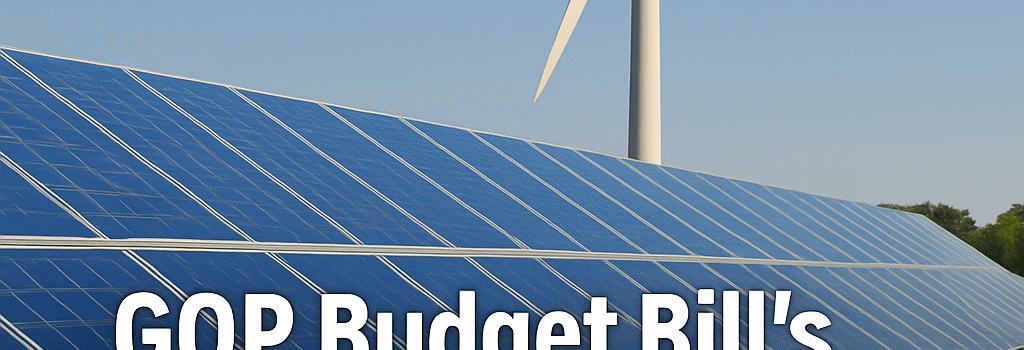GOP Budget Bill’s Impact on U.S. Renewable Energy Growth

By rewriting federal budget rules to end most clean-energy tax credits and impose new tariffs on solar imports, a bloc of Republican senators is poised to undercut critical incentives that have driven record wind and solar deployment in the United States. The proposed changes could reverse years of technological progress, destabilize the grid, and lock in continued reliance on fossil fuels.
Key Provisions and Immediate Impacts
- Sunset of Investment Tax Credit (ITC) and Production Tax Credit (PTC): Removes the 30 percent ITC for residential and utility‐scale solar projects after 2025 and phases out the 2.5 cent/kWh PTC for wind generation.
- New Solar Tariffs: Imposes a 15 percent tariff on imported photovoltaic modules and cells, rising to 30 percent within three years, potentially increasing module costs by $0.10–$0.15/W.
- Elimination of Heat Pump Credits: Expires the maximum $2,000 consumer credit for high-efficiency air-source and ground-source heat pumps.
Projects already in advanced planning could see financing withdrawn, and manufacturers may relocate to more stable markets. According to Rhodium Group modeling, these measures would add roughly 4 billion tonnes of CO₂ emissions to the next decade—equivalent to powering 200 million homes for a year.
Expert Voices and Industry Data
“These changes lock in decades of avoidable air pollution and climate damage,” wrote Stanford researcher Mark Z. Jacobson. “We’re looking at up to 100,000 premature deaths annually due to particulate matter from additional fossil-fuel combustion.”
Industry analysts estimate the tariff hike alone could increase utility-scale solar capex by 5–8 percent. The National Renewable Energy Laboratory (NREL) recently published data showing levelized cost of electricity (LCOE) for solar PV at $28–$37/MWh—50 percent cheaper than new combined-cycle gas plants. Removing the ITC shifts that balance back toward fossil generation.
Political and Regulatory Context
On June 27, Secretary of Energy Chris Wright asserted that wind and solar raise consumer bills and strain grid reliability. No supporting peer‐reviewed studies were cited. Meanwhile, nonpartisan research by the Energy Information Administration (EIA) reports U.S. retail electricity prices have dropped by 10 percent in states with high renewable penetration. Grid operators in California and Texas now integrate over 40 percent variable renewables without compromising stability, thanks to advanced inverter technology and demand-response programs.
New Section: Technical Impact on Grid Reliability
Renewable integration relies on:
- Advanced Inverter Controls: Grid-forming inverters can mimic synchronous generators, improving frequency and voltage regulation.
- Energy Storage Pairings: Lithium-ion and flow batteries, at utility scale, provide fast frequency response and shifting capacity. Levelized cost for battery storage has fallen from $400/kWh in 2015 to under $200/kWh today.
- Smart Grid and Demand Response: Automated load shifting and real-time pricing smooth peak demand, reducing the need for peaker plants.
Removing subsidies threatens investment in these critical grid upgrades just as peak heatwaves and storm events increase system stress.
New Section: Supply Chain and Manufacturing Concerns
The proposed tariffs will also hit the U.S. photovoltaic and inverter manufacturing resurgence. Since 2023, Congress‐backed programs like the Advanced Manufacturing Production Credit have spurred domestic factories capable of 10 GW of annual panel output. Tariffs risk idle capacity and jeopardize thousands of manufacturing jobs, reversing gains made under the Inflation Reduction Act.
New Section: International Competitive Landscape
China today controls over 80 percent of global polysilicon and solar panel supply. Europe and India have both enacted long-term incentive frameworks to scale renewables. By contrast, the U.S. rollback cedes technological leadership, impacting future exports of U.S.-made inverters and storage systems, which already account for $3 billion in annual trade.
Economic and Job Market Implications
Sean McGarvey of North America’s Building Trades Unions warns the budget could cost 1.75 million construction jobs and eliminate 3 billion work hours—translating to $148 billion in lost wages. Clean-energy manufacturing currently employs 532,000 workers, compared to 180,000 in coal mining. A shift back to fossil fuels undermines that growth.
Global Climate Stakes
Climate models show that without accelerated renewables, the U.S. risks overshooting its Paris Agreement targets by 40 percent. Detailed analysis by Oil Change International finds fossil‐fuel subsidies already exceed $20 billion annually. Scaling them further deepens the greenhouse gas legacy we leave future generations.
“This is a bonus for fossil fuels at the expense of American innovation and future economic resilience,” notes University of Bristol psychologist Stephan Lewandowsky. “Global competitors will seize the renewable-tech crown.”
Latest Developments: On July 2, several Senate Republicans signaled readiness to negotiate a two-year extension for consumer credits only, but utility scale and manufacturing incentives remain in jeopardy. A coalition of 25 governors, representing both parties, has sent a joint letter urging preservation of all clean energy subsidies.
Conclusion
The emerging budget battle is more than a line-item fight. It shapes the velocity of U.S. decarbonization, the stability of the electrical grid, and the competitiveness of an entire high-tech industry. As negotiations unfold, stakeholders across government, industry, and civil society will be watching closely.